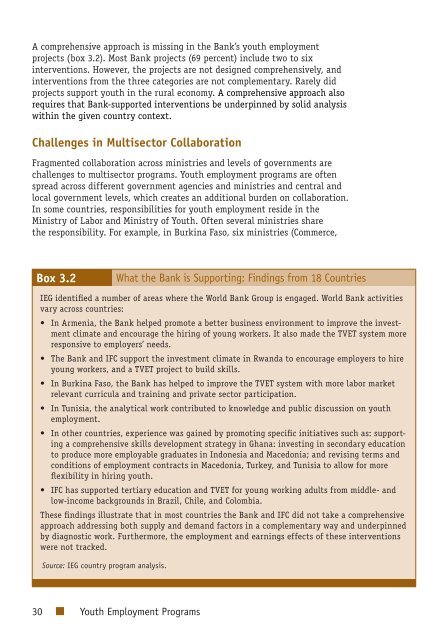Youth Employment Programs - Independent Evaluation Group
Youth Employment Programs - Independent Evaluation Group
Youth Employment Programs - Independent Evaluation Group
You also want an ePaper? Increase the reach of your titles
YUMPU automatically turns print PDFs into web optimized ePapers that Google loves.
A comprehensive approach is missing in the Bank’s youth employmentprojects (box 3.2). Most Bank projects (69 percent) include two to sixinterventions. However, the projects are not designed comprehensively, andinterventions from the three categories are not complementary. Rarely didprojects support youth in the rural economy. A comprehensive approach alsorequires that Bank-supported interventions be underpinned by solid analysiswithin the given country context.Challenges in Multisector CollaborationFragmented collaboration across ministries and levels of governments arechallenges to multisector programs. <strong>Youth</strong> employment programs are oftenspread across different government agencies and ministries and central andlocal government levels, which creates an additional burden on collaboration.In some countries, responsibilities for youth employment reside in theMinistry of Labor and Ministry of <strong>Youth</strong>. Often several ministries sharethe responsibility. For example, in Burkina Faso, six ministries (Commerce,Box 3.2What the Bank is Supporting: Findings from 18 CountriesIEG identified a number of areas where the World Bank <strong>Group</strong> is engaged. World Bank activitiesvary across countries:• In Armenia, the Bank helped promote a better business environment to improve the investmentclimate and encourage the hiring of young workers. It also made the TVET system moreresponsive to employers’ needs.• The Bank and IFC support the investment climate in Rwanda to encourage employers to hireyoung workers, and a TVET project to build skills.• In Burkina Faso, the Bank has helped to improve the TVET system with more labor marketrelevant curricula and training and private sector participation.• In Tunisia, the analytical work contributed to knowledge and public discussion on youthemployment.• In other countries, experience was gained by promoting specific initiatives such as: supportinga comprehensive skills development strategy in Ghana: investing in secondary educationto produce more employable graduates in Indonesia and Macedonia; and revising terms andconditions of employment contracts in Macedonia, Turkey, and Tunisia to allow for moreflexibility in hiring youth.• IFC has supported tertiary education and TVET for young working adults from middle- andlow-income backgrounds in Brazil, Chile, and Colombia.These findings illustrate that in most countries the Bank and IFC did not take a comprehensiveapproach addressing both supply and demand factors in a complementary way and underpinnedby diagnostic work. Furthermore, the employment and earnings effects of these interventionswere not tracked.Source: IEG country program analysis.30 <strong>Youth</strong> <strong>Employment</strong> <strong>Programs</strong>
















